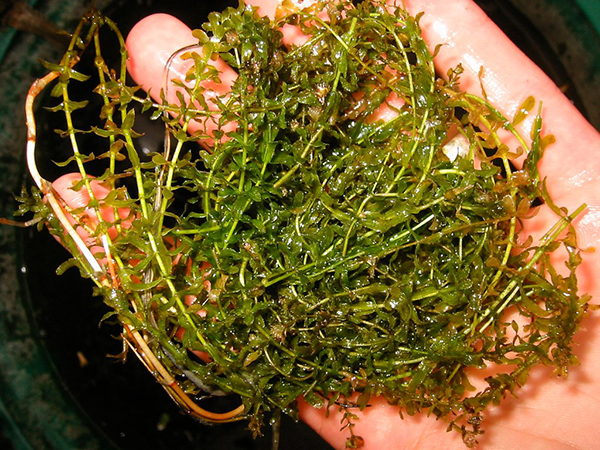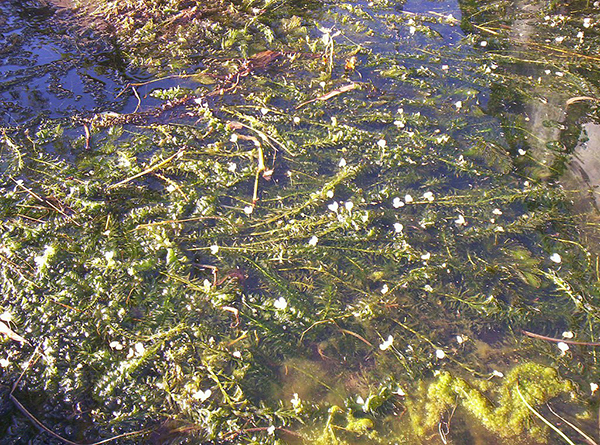A non-native mussel and three species of non-native aquatic vegetation have become established in Kentucky’s major lakes.
Zebra Mussels endanger native mussel populations and affect the food chain, water clarity and spawning substrate of native gamefish species.
Zebra Mussels are present in Kentucky Lake, Lake Barkley, Dale Hollow Lake, Taylorsville Lake, Carr Creek Lake, Dewey Lake, and Fishtrap Lake.
Three species of rooted, submerged non-native aquatic vegetation are widespread across the state and thriving in many of Kentucky’s major lakes.
Eurasian Water Milfoil, Hydrilla and Brazilian Elodea are all highly invasive species that affect water quality, compete with native aquatic plants for growing space and sunlight, impact game fish population dynamics and spawning, and impede vessel navigation in shallow embayments and at boat launching ramps.
Zebra Mussel
The Zebra Mussel (Dreissena polymorpha) is native to the lakes of southern Russia and Ukraine.
The thumbnail-size, D-shaped brown or yellow-striped mussel became established in the Great Lakes in 1986 and has since populated most of the connected drainages, including the Ohio, Mississippi, Cumberland, and Tennessee Rivers.
Thought to have been brought to North America from Europe in the ballast of freighters, the Zebra Mussel filters large volumes of water, while consuming zooplankton, the primary food of young-of-the-year gamefish species. Dense clusters of adult Zebra Mussels, as many as 100,000 in about a square yard, encrust bottom structure, affecting spawning substrate for gamefish.
The first verified sighting of Zebra Mussels in Kentucky occurred in November 1991 in the lower Ohio River near Paducah. Research has shown that Zebra Mussels can outcompete native species of mussels, leading to their decline and disappearance. A female Zebra Mussel can produce 30,000 to 1 million eggs per year.
Anglers can help stop the spread of the Zebra Mussels and protect their boats by observing these precautions:
• Flush the outboard, bilge, and live well with uncontaminated water to remove veligers, the larval stage of the mussel, that are so small they are invisible to the naked eye.
Zebra Mussels can live out of the water for up to 10 days but cannot tolerate prolonged heat. A practical remedy is to dry-dock your boat on its trailer for several days in the hot sun.
Eurasian Water Milfoil
Eurasian Water Milfoil (Myriophyllum spicatum) is native to Europe, Asia and Africa, and was likely introduced into North America in the 1940s.
“Milfoil is widely spread across the state, in many lakes and farm ponds,” said Jeff Ross, Assistant Director of the Fisheries Division for the management districts of the Kentucky Department of Fish and Wildlife Resources (KDFWR). “A certain amount of aquatic vegetation is good for a lake but when mats get so thick that they restrict water movement, lakes can become stagnant.”
This highly invasive species can spread quickly, and negatively impact fisheries. The dense mats create microhabitats for juvenile fish but obstruct space for larger fish, disrupting normal feeding patterns and movements into the shallows to spawn.
Dense growth can also lead to hypoxic zones. “Aquatic plants create (dissolved) oxygen in the water by day and use it at night,” said Ross. “But if mats get too dense oxygen levels can be drawn down to critically low levels at night.”
Hydrilla
Hydrilla (Hydrilla verticillata) is native to Asia, Africa and Australia.
It is believed that Hydrilla became established in the U.S. following several accidental and/or intentional releases in the 1950s and 1960s from aquariums into waterways in Florida.
By the late 1990s, Hydrilla had spread throughout Florida and the southeastern U.S.
It’s uncertain exactly when and how Hydrilla reached Kentucky waters, but it has been in Kentucky’s major lakes for at least 15 years and is now established in Carr Creek Lake, Cave Run Lake, Dewey Lake, Greenbo Lake and Paintsville Lake.
Hydrilla is an aggressive and competitive plant that displaces native aquatic plant species and has caused severe economic, environmental, and ecological damage across the country. Removal treatments by mechanical means or by applications of herbicides are extremely expensive, and often more than fish and wildlife agencies can afford.
Brazilian Elodea
Brazilian Elodea (Egeria densa) is native to South America, mainly southeastern Brazil, Argentina and Uruguay.
It is an invasive species that can grow in water up to 13 feet deep. A small white flower blooms at the surface.
Hydrilla and Brazilian Elodea thrive in Greenbo Lake, where Grass Carp have been stocked as a biological control measure, in an effort to stop the spread of nuisance vegetation.
Elodea is most aggressive in shallow waterways, forming thick mats that trap sediments, crowd out native vegetation, and impede the migration and spawning of fish in streams.
Anglers need to look over their boats carefully after every fishing trip to lakes where these nuisance plant species are present, especially if they are planning on traveling to another lake the next day.
“Check the boat, motor prop and trailer, and remove any plant fragments,” said Ross. If you can, spray everything down with a hose.”
Even the smallest plant filament or rhizome will root, and spread these invasive plants. Don’t encourage aquatic hitchhikers!
For more information on how to prevent the spread of non-native species in Kentucky, visit fw.ky.gov



























